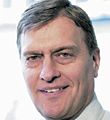Pervasive computing: The walls are listening

Pervasive-computing systems could make even conference rooms brainy, according to the Smart Space Laboratory researchers at the National Institute of Standards and Technology.
Pervasive-computing systems could make even conference rooms brainy, according to the Smart Space Laboratory researchers at the National Institute of Standards and Technology.Martin Herman, chief of information access in NIST's information technology lab, believes pervasive computing will come about through large numbers of small devices and sensors, some so unobtrusive that people won't know they're interacting with a computer at all.Computers and sensors "can be embedded in your environment. They can be portable ones that you carry with you," such as personal digital assistants, Herman said. "They could be in your clothing, in your watch, in your shoe, in your eyeglasses ? anywhere. In chairs, in tables, in the walls."Herman's team connected a variety of off-the-shelf devices to a prototype meeting room that can take dictation, track individual speakers and, perhaps some day, answer spoken questions.The researchers designed the NIST Smart Flow System with open-source middleware to smooth the acquisition and archiving of large amounts of data, computer specialist Vince Stanford said. The middleware links commercially available voice-recognition software, video cameras and microphones.The Smart Space lab tries the latest technologies that vendors are developing and reports the results. The lab, whose home page is at , is working with industry to develop usability standards, Herman said.Pervasive-computing devices talk to each other through a LAN, wired or wireless networks or a combination of them. They can even do "what we call invisible computation," Herman said. "If you want to compute, you sit down with a desktop PC or PDA or laptop. But invisible computation means that you're not even aware there's computation in the environment."The Smart Space lab's prototype voice-recognition conference room at NIST's Gaithersburg, Md., headquarters has several arrays of microphones instead of a single mike. Stanford dictated a few sentences punctuated by saying "new paragraph," "comma" and "period" aloud.The microphone array serves not only for speech recognition ? for example, to make a simple transcript of a meeting ? but also for tracking people as they move around the room."This is like an acoustic telescope," Stanford said of the microphone arrays, which detect the location of each voice and pass it to one of five video cameras. Behind the meeting room is a data acquisition system based on a Linux cluster of 14 computers with 400-MHz to 1.2-GHz CPUs.The cluster has a couple of 1T RAID storage arrays, plus three 64-channel data acquisition boards and three eight-channel, 24-bit audio acquisition boards. Its Gigabit Ethernet network switch is from 3Com Corp. of Santa Clara, Calif.The open-source clustering software can harness up to 24 computers, Stanford said. NIST has made the source code and documentation available for download at www.nist.gov/smartspace/toolChest/nsfs/.Future knowledge workers can move around their smart spaces without worrying about being near computers or microphones, Herman said."If I'm talking to you, and a computer can follow what the conversation is about, it can go out and get services," Herman said. "It can look up stuff on the Internet to help us in the discussion."That remains a distant goal for the prototype meeting room. Last fall, the Smart Space group built a duplicate meeting-room test bed for other NIST researchers, Stanford said. The group is working with NIST physics and chemistry labs to adapt the Smart Flow middleware to their data-distribution needs, such as results from the filtration of single strands of DNA.


www.nist.gov/smartspace
Government Computer News Staff Writer
Patricia Daukantas can be reached at pdaukantas@postnewsweektech.com.

Martin Herman

Computer specialist Vince Stanford said researchers designed the NIST Smart Flow System with open-source middleware to smooth the acquisition and archiving of large amounts of data.
www.nist.gov/smartspace
Government Computer News Staff Writer
Patricia Daukantas can be reached at pdaukantas@postnewsweektech.com.
NEXT STORY: Start your engines